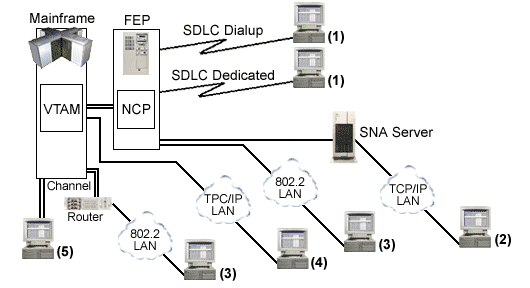
BARR/NJE uses an IBM-based protocol that works over SNA. With Barr-developed SNA link services, you can connect a network of computers to the mainframe without an SNA gateway. This simplifies the configuration process because it is only necessary to configure the host and the Barr software. Alternatively, BARR/NJE can connect through Microsoft’s SNA Server, which is an SNA gateway, or a channel-attached (CTC) connection. The Barr SNA link services and SNA Server emulate a 3174 Cluster Controller, a PU Acronym for Physical Unit. In SNA, software responsible for managing the resources of a node, such as data links. A PU supports a connection to the host (SSCP) for gathering network management statistics. type 2.
The following diagram shows the connection types available to connect BARR/NJE to your mainframe SNA network.

|
Connection Type |
Requires |
|
(1) SDLC |
BARR/SYNC adapter |
|
(2) MS/LUA |
SNA gateway software (Must be purchased separately) |
|
(3) 802.2 LLC2 |
DLC protocol (Comes with operating system) |
|
(4) HPR/IP |
Ethernet adapter |
|
(5) Channel |
BARR/CHANNEL adapter |
When you configure BARR/NJE, there are three available connection types: Barr SNA, SNA, and CTC.
The Barr-developed link services connect a network of computers in a LAN to the mainframe, or establish individual connections between remote computers and the mainframe using modems. This option also provides an easier configuration process because it is not necessary to configure an SNA gateway. If you use JES2 as your host spooler, you can also configure auto-start parameters. Barr SNA provides the following communication links.
802.2 LLC2 – Uses any interface network card such as Ethernet or a token ring to connect to the mainframe. Requires installing the DLC protocol, which comes with your operating system.
SDLC – Uses a modem or CSU/DSU to connect to the mainframe. Requires the BARR SYNC modem adapter, which we provide to you.
HPR/IP – Uses any interface network card such as Ethernet to connect to the mainframe.
The Microsoft LUA option connects a network of computers in a LAN (using TCP/IP) to your mainframe. An SNA gateway, Microsoft SNA Server or HIS, is necessary to interface between the remote computers and the mainframe. With SNA, you must configure the host, the SNA gateway, and BARR/NJE. If you use JES2 as your host spooler, you can also configure auto-start parameters.
The channel-to-channel (CTC) option connects remote computers directly to the mainframe using channel cables. The channel cables transfer data at a faster rate than the other connection types. CTC, however, does not provide the same flexibility, such as giving you access to networks over long distances. With CTC, you only need to configure the host and BARR/NJE; an SNA gateway is not required.